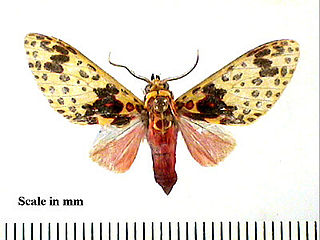
The Thyrididae comprise the family of picture-winged leaf moths. They are the only family in the superfamily Thyridoidea, which sometimes has been included in the Pyraloidea, but this isn't supported by cladistic analysis.

Amaxia is a genus of arctiine tussock moths in the family Erebidae. The type species of the genus is Amaxia pardalisWalker, 1855.
Amaxia duchatae is a moth of the family Erebidae. It was described by Hervé de Toulgoët in 1987. It is found in French Guiana.
Amaxia elongata is a moth of the family Erebidae. It was described by Hervé de Toulgoët in 1987. It is found in French Guiana.
Amaxia fallaciosa is a moth of the family Erebidae. It was described by Hervé de Toulgoët in 1989. It is found in Mexico.
Amaxia inopinata is a moth of the family Erebidae. It was described by Hervé de Toulgoët in 1989. It is found in Ecuador.
Amaxia ornata is a moth of the family Erebidae. It was described by Hervé de Toulgoët in 1990. It is found in French Guiana.
Amaxia fallax is a moth of the family Erebidae. It was described by Hervé de Toulgoët in 1998. It is found in French Guiana.
Amaxia apyga is a moth of the family Erebidae. It was described by George Hampson in 1901. It is found in Costa Rica.
Amaxia beata is a moth of the subfamily Arctiinae. It was described by Paul Dognin in 1909. It is found in French Guiana.
Amaxia disconsistens is a moth of the family Erebidae. It was described by Paul Dognin in 1923. It is found in Brazil.
Amaxia lepida is a moth of the family Erebidae. It was described by Schaus in 1912. It is found in Costa Rica.
Carales astur, the astur moth, is a moth of the family Erebidae. It was described by Pieter Cramer in 1777. It is found in Mexico, Guatemala, Costa Rica, Panama, Honduras, Nicaragua, Colombia, Suriname, Brazil, French Guiana, Paraguay, Argentina, Venezuela, Ecuador, Peru and Bolivia.

Cosmosoma teuthras is a moth of the subfamily Arctiinae. It was described by Francis Walker in 1854. It is found in Mexico, Guatemala, Costa Rica, Panama, Colombia, Venezuela and Brazil.
Eucereon pica is a moth of the subfamily Arctiinae. It was described by Francis Walker in 1855. It is found in Costa Rica, Peru and Rio de Janeiro, Brazil.
Eucereon quadricolor is a moth of the subfamily Arctiinae. It was described by Francis Walker in 1855. It is found in Mexico, Costa Rica, Panama and Rio de Janeiro, Brazil.
Hypercompe caudata is a moth of the family Erebidae. It was described by Francis Walker in 1855. It is found in Texas, southern Arizona, Mexico, Costa Rica, Honduras and Nicaragua.
Idalus vitrea is a moth of the family Erebidae. It was described by Pieter Cramer in 1780. It is found in Mexico, Guatemala, Honduras, Costa Rica, Panama, Paraguay, Peru, French Guiana, Bolivia, Brazil, and Venezuela.

Lophocampa annulosa, the Santa Ana tussock moth, is a moth of the family Erebidae. It was described by Francis Walker in 1855. It is found in southern Texas, southern Arizona, Mexico, Costa Rica, Ecuador, Venezuela, Peru, Suriname, Brazil, Argentina and Trinidad.
Pelochyta cinerea is a moth of the family Erebidae. It was described by Francis Walker in 1855. It is found in Costa Rica, Panama, Colombia, Venezuela, Ecuador, Bolivia and Brazil.






